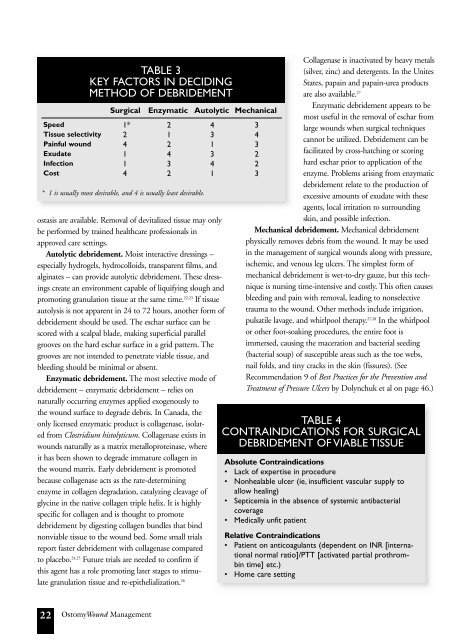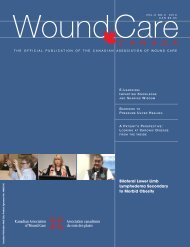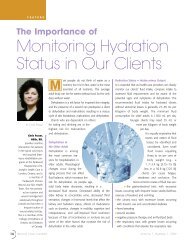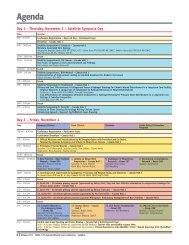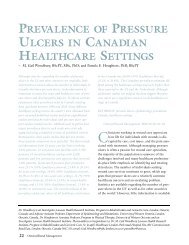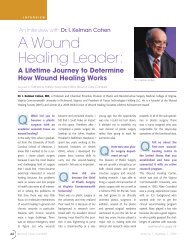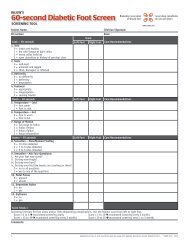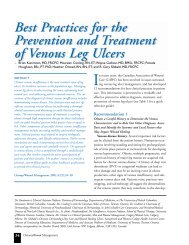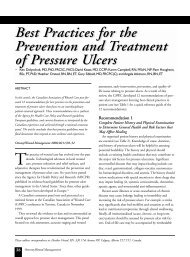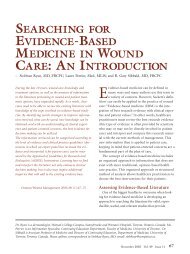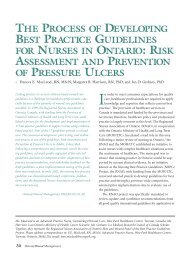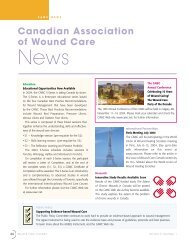Preparing the Wound Bed – Debridement, Bacterial Balance, and ...
Preparing the Wound Bed – Debridement, Bacterial Balance, and ...
Preparing the Wound Bed – Debridement, Bacterial Balance, and ...
You also want an ePaper? Increase the reach of your titles
YUMPU automatically turns print PDFs into web optimized ePapers that Google loves.
Speed<br />
Tissue selectivity<br />
Painful wound<br />
Exudate<br />
Infection<br />
Cost<br />
TABLE 3<br />
KEY FACTORS IN DECIDING<br />
METHOD OF DEBRIDEMENT<br />
ostasis are available. Removal of devitalized tissue may only<br />
be performed by trained healthcare professionals in<br />
approved care settings.<br />
Autolytic debridement. Moist interactive dressings <strong>–</strong><br />
especially hydrogels, hydrocolloids, transparent films, <strong>and</strong><br />
alginates <strong>–</strong> can provide autolytic debridement. These dressings<br />
create an environment capable of liquifying slough <strong>and</strong><br />
promoting granulation tissue at <strong>the</strong> same time. 22,23 If tissue<br />
autolysis is not apparent in 24 to 72 hours, ano<strong>the</strong>r form of<br />
debridement should be used. The eschar surface can be<br />
scored with a scalpal blade, making superficial parallel<br />
grooves on <strong>the</strong> hard eschar surface in a grid pattern. The<br />
grooves are not intended to penetrate viable tissue, <strong>and</strong><br />
bleeding should be minimal or absent.<br />
Enzymatic debridement. The most selective mode of<br />
debridement <strong>–</strong> enzymatic debridement <strong>–</strong> relies on<br />
naturally occurring enzymes applied exogenously to<br />
<strong>the</strong> wound surface to degrade debris. In Canada, <strong>the</strong><br />
only licensed enzymatic product is collagenase, isolated<br />
from Clostridium histolyticum. Collagenase exists in<br />
wounds naturally as a matrix metalloproteinase, where<br />
it has been shown to degrade immature collagen in<br />
<strong>the</strong> wound matrix. Early debridement is promoted<br />
because collagenase acts as <strong>the</strong> rate-determining<br />
enzyme in collagen degradation, catalyzing cleavage of<br />
glycine in <strong>the</strong> native collagen triple helix. It is highly<br />
specific for collagen <strong>and</strong> is thought to promote<br />
debridement by digesting collagen bundles that bind<br />
nonviable tissue to <strong>the</strong> wound bed. Some small trials<br />
report faster debridement with collagenase compared<br />
to placebo. 24,25 Future trials are needed to confirm if<br />
this agent has a role promoting later stages to stimulate<br />
granulation tissue <strong>and</strong> re-epi<strong>the</strong>lialization. 26<br />
22 Ostomy<strong>Wound</strong> Management<br />
Surgical Enzymatic Autolytic Mechanical<br />
1*<br />
2<br />
4<br />
1<br />
1<br />
4<br />
* 1 is usually most desirable, <strong>and</strong> 4 is usually least desirable.<br />
2<br />
1<br />
2<br />
4<br />
3<br />
2<br />
4<br />
3<br />
1<br />
3<br />
4<br />
1<br />
3<br />
4<br />
3<br />
2<br />
2<br />
3<br />
Collagenase is inactivated by heavy metals<br />
(silver, zinc) <strong>and</strong> detergents. In <strong>the</strong> Unites<br />
States, papain <strong>and</strong> papain-urea products<br />
are also available. 27<br />
Enzymatic debridement appears to be<br />
most useful in <strong>the</strong> removal of eschar from<br />
large wounds when surgical techniques<br />
cannot be utilized. <strong>Debridement</strong> can be<br />
facilitated by cross-hatching or scoring<br />
hard eschar prior to application of <strong>the</strong><br />
enzyme. Problems arising from enzymatic<br />
debridement relate to <strong>the</strong> production of<br />
excessive amounts of exudate with <strong>the</strong>se<br />
agents, local irritation to surrounding<br />
skin, <strong>and</strong> possible infection.<br />
Mechanical debridement. Mechanical debridement<br />
physically removes debris from <strong>the</strong> wound. It may be used<br />
in <strong>the</strong> management of surgical wounds along with pressure,<br />
ischemic, <strong>and</strong> venous leg ulcers. The simplest form of<br />
mechanical debridement is wet-to-dry gauze, but this technique<br />
is nursing time-intensive <strong>and</strong> costly. This often causes<br />
bleeding <strong>and</strong> pain with removal, leading to nonselective<br />
trauma to <strong>the</strong> wound. O<strong>the</strong>r methods include irrigation,<br />
pulsatile lavage, <strong>and</strong> whirlpool <strong>the</strong>rapy. 27,28 In <strong>the</strong> whirlpool<br />
or o<strong>the</strong>r foot-soaking procedures, <strong>the</strong> entire foot is<br />
immersed, causing <strong>the</strong> maceration <strong>and</strong> bacterial seeding<br />
(bacterial soup) of susceptible areas such as <strong>the</strong> toe webs,<br />
nail folds, <strong>and</strong> tiny cracks in <strong>the</strong> skin (fissures). (See<br />
Recommendation 9 of Best Practices for <strong>the</strong> Prevention <strong>and</strong><br />
Treatment of Pressure Ulcers by Dolynchuk et al on page 46.)<br />
TABLE 4<br />
CONTRAINDICATIONS FOR SURGICAL<br />
DEBRIDEMENT OF VIABLE TISSUE<br />
Absolute Contraindications<br />
• Lack of expertise in procedure<br />
• Nonhealable ulcer (ie, insufficient vascular supply to<br />
allow healing)<br />
• Septicemia in <strong>the</strong> absence of systemic antibacterial<br />
coverage<br />
• Medically unfit patient<br />
Relative Contraindications<br />
• Patient on anticoagulants (dependent on INR [international<br />
normal ratio]/PTT [activated partial prothrombin<br />
time] etc.)<br />
• Home care setting


